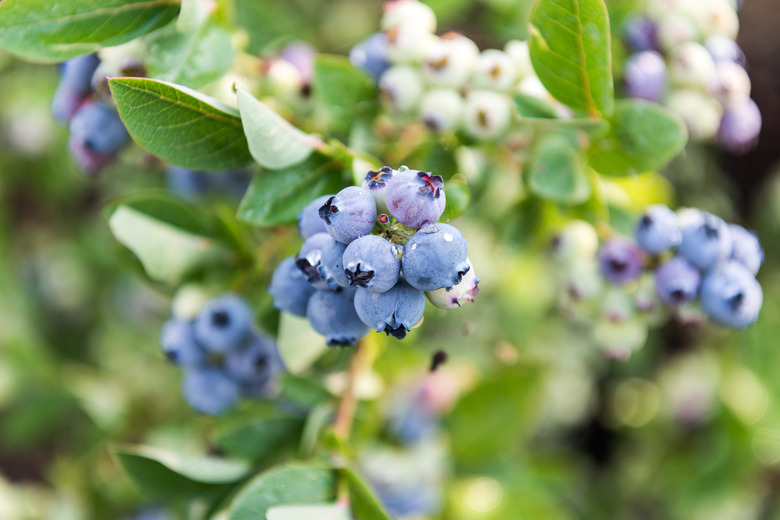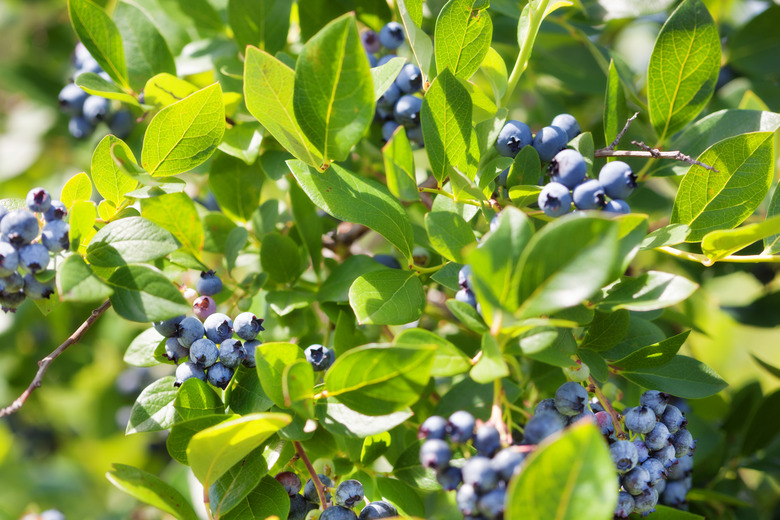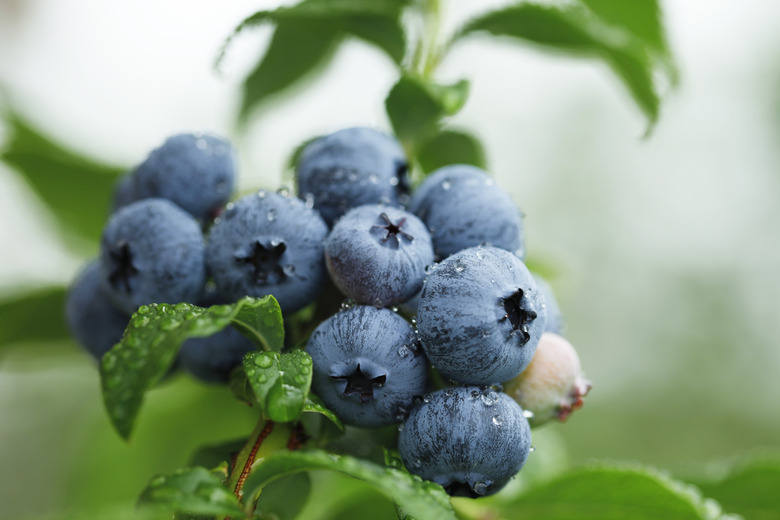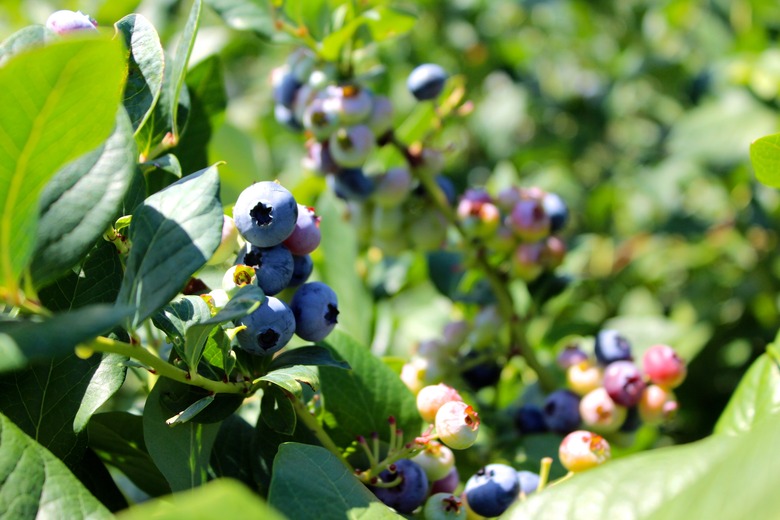How To Grow Blueberries
We may receive a commission on purchases made from links.
- Best uses for blueberries
- How to grow blueberries
- In what zone do blueberries grow best?
- When should you plant blueberries?
- Soil, sunlight and water recommendations for blueberries
- How to winterize blueberries
- How to harvest blueberries
- Common pests and other problems for blueberries
- Common diseases for blueberries
Blueberries (Vaccinium spp.) may be a popular superfood these days, but blueberries as we know them are actually a recent creation, first cultivated around 100 years ago. Prior to that, only small, wild blueberries existed. Growing blueberry bushes in your yard will not only allow you to enjoy the flavor of sweet berries at the peak of freshness but will also enhance your landscape.
In spring, the perennial shrubs will grow white, bell-shaped flowers. In summer, blueberries are as nice to behold as they are to eat, and in fall, the bright, scarlet foliage will provide a striking addition to your garden. Best of all, once blueberries are established, they are hardy plants that can survive up to 50 years even through frost, drought, pest invasions and other conditions that would kill off many other plants.
Best Uses for Blueberries
Best Uses for Blueberries
Blueberries are part of the heath family of plants (Ericaceae), which also includes berries such as the lingonberry, cranberry, huckleberry and bilberry, and they are also related to azaleas and rhododendrons. The small, flavorful berries are not only versatile, but they can also be used in pies, jams, salads or just eaten by the handful. And they're also incredibly healthy —rightfully earning their title as a super food. In fact, while an entire cup of blueberries has only 84 calories, they pack in 4 grams of fiber, 24% of your daily recommended vitamin C, 36% of the recommended daily intake of Vitamin K and 25% of your necessary daily manganese. On top of all this, they contain more antioxidants than just about any other common fruit or vegetable and can even reduce blood pressure.
The plants have a small, shallow root system that can do well just about anywhere, including pots and planters, as long as the soil is acidic and drains well. As a result, they're a great option for novice gardeners as well as those with limited growing space. Of course, their beautiful foliage from spring to fall can make an attractive addition to an ornamental garden as well.
While blueberries are naturally self-pollinating, having multiple blueberry varieties can result in a longer harvesting season, and cross-pollination can ensure higher fruit production. There are three main varieties of blueberries: highbush (Vaccinium corymbosum, zones 3-8), lowbush (Vaccinium angustifolium, zones 2-8) and rabbiteye (Vaccinium virgatum, formerly V. ashei, zones 6-9). Highbush types grow around 12 feet tall; lowbush plants grow only 2 feet tall, and rabbiteyes grow up to an impressive 15 feet tall.
There are also hybrid blueberry varieties, such as the popular half-high variety that has the hardiness and height of the lowbush blueberry plant with increased fruiting like a highbush. You can even purchase hybrid blueberry plants that actually grow pink berries, such as Pink Lemonade and Pink Champagne, if you want to add a little color variety in your home garden.
Avoid planting blueberries near trees because the trees can block out light and suck up too much moisture from the soil. Similarly, while many people like to grow many different varieties of berries near one another, blueberries require much more acidic soil than raspberries, blackberries and strawberries, and since you're looking to maximize fruit production, it's best to grow blueberries away from these berries.
How to Grow Blueberries
How to Grow Blueberries
- Common Name: Blueberry
- Botanical Name: Vaccinium spp.
- When to Plant: Spring and fall
- USDA Zones: 2-9, depending on species and cultivar
- Sun Exposure: Full sun
- Soil Type: Well-draining, moist,
acidic soil that is high in nutrients - When it's in Trouble: Berries and foliage are eaten by pests; berries
shrivel up and fall to the ground before ripening - When it's Thriving: Leaves are bright green during spring and summer and
crimson red during fall before falling off in winter. Look for small,
white flowers to appear in spring and blueberry clusters in summer.
Starting Blueberries From Potted Plants or Bare-Root Plants
Blueberry bushes may be sold in containers with soil or as bare-root plants. When working with bare-root plants, it's best to soak the root ball for a few hours prior to planting. Otherwise, the process is essentially the same.
Prepare the entire planting area instead of amending each hole by incorporating organic matter such as compost, peat moss, aged sawdust, or oak-leaf mold into the native soil. Dig planting holes as deep as the root ball and 18 inches wide, spacing plants approximately 4 to 5 feet apart with 8 feet between rows of plants. Add each bush, gently spreading out the roots. Backfill the hole, gently tamping the soil around the roots, and then add 2 to 4 inches of mulch above the soil level, pulling the mulch away from the stems. Remove 25 percent of the stems on the bush after planting to encourage new growth; this will be replaced quickly after planting.
A month later, apply 1/2 ounce of 10-10-10 fertilizer 6 to 12 inches from the base of the plant, if soil-test results indicate the need for increasing soil fertility. For the first year or two, pinch back any blossoms that develop on your new plant to force it to focus its energy on growth rather than fruit production. This will result in greater production in the future, which will add up over the plant's lengthy life span. Peak berry production begins after the plants are six years old.
In What Zone Do Blueberries Grow Best?
In What Zone Do Blueberries Grow Best?
The common highbush variety does best in USDA hardiness zones 3-8. Lowbush blueberries do best with frigid temperatures and snow cover, thriving in zones 2-7. On the other hand, rabbiteye blueberries are not only tolerant of poor soil but also warm temperatures and are best adapted for zones 6-9. When it comes to highbush blueberry cultivars, Northern highbush varieties like Bluecrop, Jersey and Patriot do better in cold temperatures, whereas Southern highbush varieties like Sunshine Blue, Gold Coast and Ozarkblue do better in warm weather. Alapaha, Brightwell, and Ochlockonee are rabbiteye cultivars that perform well in the South.
When Should You Plant Blueberries?
When Should You Plant Blueberries?
In most regions, it's important to avoid planting when there is a risk of frost, so the best time for planting blueberries is in spring after the frosts have ended or fall before the first frosts appear. In warmer areas with minimal frost, you can plant in fall after the peak of summer heat is long gone all the way through midspring as long as it's before summer heat starts to take hold again.
Soil, Sunlight and Water Recommendations for Blueberries
Soil, Sunlight and Water Recommendations for Blueberries
If you want to grow blueberries, one of the most important things on which to focus is the soil. It must drain well but still hold water, be acidic and be filled with rich, organic material. Loamy soil is ideal for drainage and moisture retention. Prior to planting, test your drainage by heavily watering the area until it develops a pool of water. If water stays standing for more than a day, it's not a good place for blueberry plants.
Blueberries like acidic soil, ideally with a pH level between 4.0 and 5.5. Purchase a soil test from either a local cooperative extension office or a garden center to determine your soil's acidity. To increase soil acidity, work in granulated sulfur or ammonium sulfate a few months in advance. While some sources claim that adding pine needles to the soil can amend the soil pH, this is a myth and will not help your blueberry bush, although pine needles can be a useful mulching material just like wood chips.
If you don't have ideal soil for blueberry bushes, consider growing them in raised beds or pots or try "hilling" them — building small, 3-foot-wide hills. These solutions will allow you to control the soil on which your plants grow and ensure the soil has sufficient drainage. Blueberry root systems do not exceed 18 inches long and usually stay within 1 foot of the stem, so as long as your raised bed, pot or hill allows this much space in every direction, the plant should do fine.
Blueberries prefer organic-rich soil. Enhance your soil with organic matter that will not add excessive nutrients to the soil such as compost, peat moss, oak-leaf mold or aged sawdust. Be sure to use 2 to 4 inches of mulch as ground cover, which will help keep moisture in the soil, protect the plants from cold weather and suppress weeds, all of which are important in protecting the shallow roots of blueberries. Fertilize once a year with 2 pounds of soybean, alfalfa or cottonseed meal per 100 square feet of soil.
When it comes to water, blueberries like a constant supply of water but not so much that the soil becomes soggy. About 1 to 2 inches of water over an entire week is an ideal amount, and using drip irrigation is a great way to provide this amount on a slow and steady basis so it can be best absorbed by the roots.
Blueberries like to have at least six hours of direct sunlight a day. More is fine, but be sure they get a little shade in the peak of the afternoon if you live somewhere that is particularly hot.
How to Winterize Blueberries
How to Winterize Blueberries
Many blueberries are particularly tolerant of cold weather, especially the lowbush variety. That being said, if you live in a cold area, you'll want to ensure there is always a 2- to 4-inch layer of mulch around the plants during the winter months in order to provide ground cover to protect the shallow roots from frost. It's also important to properly prune blueberry bushes in the dormant period no matter your region.
Always prune bushes before leaf buds have formed. Remove spindly twigs, branches that rub against one another or the ground and any branches that will block light from the rest of the plant when the leaves grow back. In the first five years, it's important to let the plant grow as much as possible and only trim those branches when actually necessary, but stems that are over six years old will produce fewer blueberries and should be removed to focus the plant's energy on more productive branches. Look for stems wider than 1 inch in diameter, as these are likely to be over six years old, and then trim these down to the ground.
When bushes have developed more than six young shoots in the previous growing season, choose the healthiest, sturdiest shoots and then prune away the remaining shoots so the bush can focus energy on growing berries and not just branches. While most pruning should only be done in the winter, always prune out dead branches or stems as you notice them.
How to Harvest Blueberries
How to Harvest Blueberries
Don't assume a berry is ripe just because it has turned blue, as this is only a sign that the berry is about to become ripe. Instead, hold a basket beneath the berry clusters and then lightly tickle them. When berries are ripe, they'll fall away from the stem and into your basket; unripe berries will stay on the plant. Check bushes once a day throughout June, July and August or berries may fall to the ground and be wasted.
Common Pests and Other Problems for Blueberries
Common Pests and Other Problems for Blueberries
Blueberries are reasonably low maintenance, but it's important to recognize that humans aren't the only creatures to find them delicious. In fact, when it comes to blueberry pests, you need to worry more about bigger animals such as birds, deer and raccoons than you do insects. These feathered and furry pests can ravage your fruiting shrubs, so you may want to drape bird netting over the bushes or even use posts and metal mesh to build a cage around the growing area. Be aware that netting can make harvesting difficult, and smaller birds may still be able to reach many of the berries.
As for insects, look out for the spotted-wing drosophila, Rhagoletis nendax and Datana ministra. Spotted-wing drosophila (often shortened to SWD) is a fruit fly that lays eggs on underripe fruit, leaving its maggots to eat the fruit from the inside. While scientists are working on an effective trap for these pests, they are not commercially available yet, so the best defense is planting blueberry varieties that ripen early since the SWD doesn't come out until August.
The blueberry maggot (Rhagoletis mendax) is another small fly that lays eggs on the blueberry so its maggots can grow on the inside. Fortunately, these bugs are easy to trap. The flies are attracted to the color red, so put out a red, round item like an apple and cover it with Tangle-Trap, a sticky material that can turn any object into a pest trap. Hang your trap among the plants and the flies will get stuck to it, leaving your plants alone.
If you are concerned that you may have maggots inside your blueberries after flies may have laid eggs on them, you can run a test by mixing a teaspoon of salt in a cup of water and then submerging the berries for 10 minutes. If maggots are in the berries, they will crawl out when submerged in saltwater, and you should see them floating in the water.
Finally, some growers have problems with the yellow-necked caterpillar (Datana ministra). This caterpillar is easy to spot, as it is covered in long, white hairs and has a yellow band around its head. Rather than eating the berries like other blueberry pests, they'll eat the foliage from the plants. Bacillus thuringiensis is an insecticide that is particularly effective on these caterpillars.
Common Diseases for Blueberries
Common Diseases for Blueberries
Overall, blueberries don't suffer from many diseases, but the mummy berry fungus can be a problem. If your fruit is wrinkling and falling to the ground before ripening, your plants may be infected. This disease is windborne and is spread from the spores of the infected fruit to young berries. Remove and destroy affected berries as you discover them. At the end of the growing season, lay out a new layer of mulch at least 2 inches thick in order to cover any mummified berries you may have so they cannot harm next year's crop.
References
- University of Minnesota Extension: Growing Blueberries in the Home Garden
- Fall Creek Farm & Nursery: How to Grow Blueberries
- U.S. Highbush Blueberry Council: Planting Blueberries
- Joe Gardener: How to Grow Bountiful Blueberries – Key Steps with Lee Reich
- Burpee: How To Grow Blueberry Plants
- The Old Farmer's Almanac: Growing Blueberries



